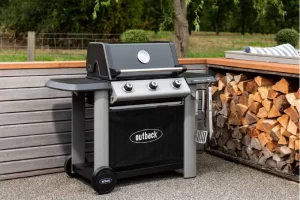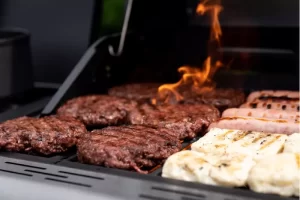Don’t Let It Stop You – Tips and Advice on Grilling in the Wind
It’s annoying. You’re hosting a get together and mother nature brings a gusty wind as her plus one. It creates some challenges for BBQ enthusiasts but doesn’t have to mean the end of the road for your afternoon.
So, You Can Grill When It’s Windy?
It seems like it may be impossible to fire up gas grills in windy conditions. And in winds that are too high, then it’s probably the case. But you can grill when it’s windy, you just need to take a few factors into account to have a successful grilling session.
General Tips for Grilling in Higher Winds
- Position your grill to minimise exposure to the wind.
- Create different heat zones for even cooking.
- Use a grill lid to shield your food from direct gusts of wind.
- Keep a spray bottle filled with water handy to control flare-ups.
- Consider a grill windscreen or building a DIY wind barrier for added protection.
- Monitor the internal temperature of your grill closely and adjust cooking times.
- Prioritise safety and don’t grill in excessively windy or severe weather.
Also read: Cold Outside? How To BBQ In the Chilly Weather
Will the Flames Get Blown Out?
Strong winds can extinguish the flames on a gas grill. But this can happen on a standard gas hob if you open the back door in the kitchen and there’s a sudden gust. So, it doesn’t have to be a deal breaker. Make sure your grill is properly positioned to reduce exposure to the wind. Set your BBQ in a sheltered area, such as near a wall or fence (not too close to wooden structures though), to create a windbreak. Be aware of any potential hazards that can blow onto the grill.
Grill windshields are available to buy, or you can build a DIY wind barrier yourself to help prevent the flames from being blown out.
Food Will Probably Take Longer to Cook
Wind creates a cooling effect which in turn can extend your cooking time. As it’s harder to maintain the temperature you want, you’ll have to adjust your approach and cook for longer. Monitor the temperature of your grill and adjust cooking times to match. A grill thermometer will help you to keep track of the temperature, so you can still serve perfectly cooked food.
Keeping food evenly cooked is a challenge too. As well as cooling the overall temperature wind can disrupt the distribution of heat, creating uneven heat. A grill with multiple burners allows you to create different heat zones, and you can use indirect heat.
Indirect cooking is a grilling technique where you place the food away from the direct heat source (the flame in this case), allowing it to cook slowly and evenly using the overall heat of the grill. In windy conditions, doing this helps create evenly cooked food. Create a two-zone set-up, where one side of the grill has the burners on as normal and the other side is turned off. This creates a cooler area where the food can better cook. This helps mitigate the uneven heat distribution caused by wind gusts.
Note: Flare-Ups Are More Likely
When fat or marinades drip onto the burner gusts of wind can fan the flames and cause flare-ups. Trim excess fat from your meat and use drip pans or aluminium foil to catch drippings. Keep a close eye on the grill and have a spray bottle filled with water nearby to help you deal with any flare-ups.
Using the Hood
A grill hood is handy anyway, helping to keep the heat inside. It helps retain moisture and flavours.
But when grilling in windy conditions, the grill hood can significantly benefit your cooking. The hood acts as a shield and by trapping heat inside the grill, the hood helps combat the cooling effect caused by the wind, ensuring that the grill remains at the desired temperature.
Using Thinner Cuts of Meat
Thinner cuts, such as steaks, chops or burgers, tend to cook faster than thicker cuts. Since wind can cool down the grill, opting for thinner cuts reduces the chances of food taking ages to cook. Thinner cuts also allow for quicker heat penetration, which can help compensate for the cooling effect of the wind. Additionally, thinner cuts are less prone to flare-ups.
When Is It Just Too Windy?
While grilling in windy conditions is possible with a little extra thought, there are times when it’s simply too windy to grill safely. If the wind is consistently strong, gusty, or accompanied by severe weather conditions, it’s best to postpone your grilling plans. Use your judgement. If things are constantly blowing away and chairs are tipping over, it might be too windy to have a comfortable get together.
Gas Safety in Windy Weather
Windy weather requires extra attention to gas safety.
- Position your grill in an area away from any flammable materials, such as trees, awnings or buildings. Choose a location where wind gusts won’t blow the flames toward potentially hazardous objects or risk anything blowing over onto your grill.
- Before grilling, inspect the gas connections, hoses and valves for any signs of damage or leaks. If you discover a leak, immediately turn off the gas supply and address it.
- If you’re using a propane grill, make sure the propane tank is securely fastened. Windy conditions can cause the tank to shift or fall, potentially damaging the gas line and leading to leaks or accidents. Ensure the tank is stable and properly attached before grilling.
- Wind can blow debris into the grill. Before grilling, check that the grill is clean and free from any blockages.
- Windy conditions can disrupt the gas flow, affecting the flame and heat output. Regularly check the flames to ensure they are burning consistently and not being blown out.
- Strong gusts of wind can potentially tip over a grill, posing a significant safety risk. Ensure your grill is stable by using a sturdy base and securing it to prevent it from toppling over.
- Always have a fire extinguisher readily available in case of emergencies.
- Stay near the grill at all times and keep an eye on the flames and cooking. Never leave a grill unattended, especially in gusty conditions.
Final Thoughts
Grilling in windy conditions can be challenging, but you can still enjoy a successful get-together. Indirect heat is a great technique for cooking in the wind. It gives you even heat distribution and by combining this with thinner cuts of meat, you can enjoy evenly cooked food, quicker. The grill hood creates a shield against the wind, helping maintain consistent temperatures. Wind won’t stop you enjoying delicious and perfectly-cooked meals.



